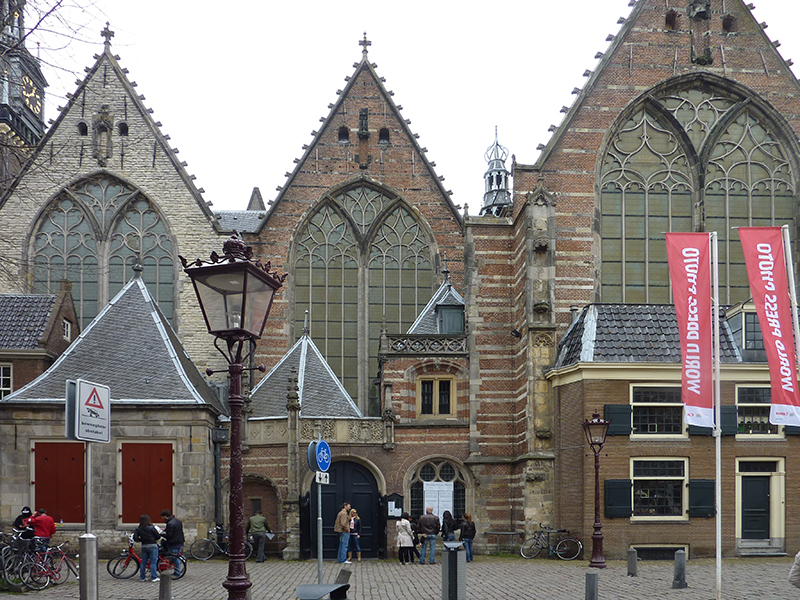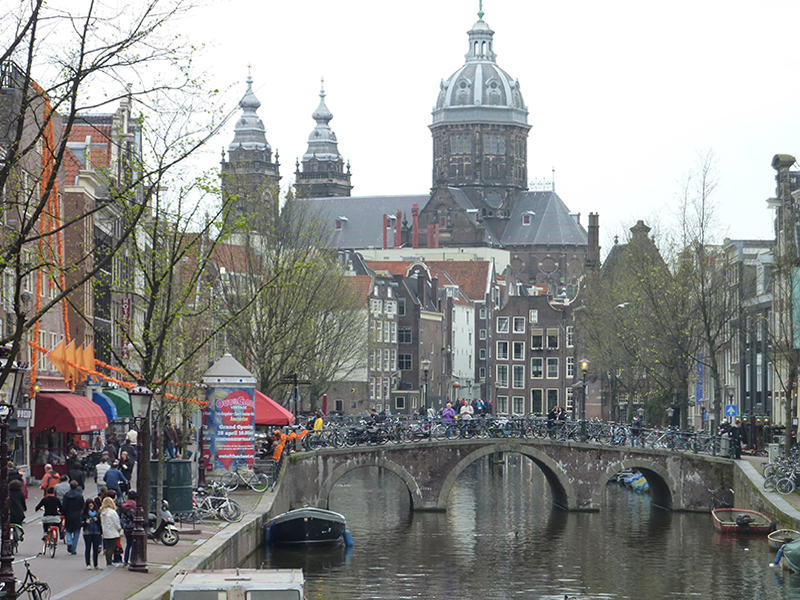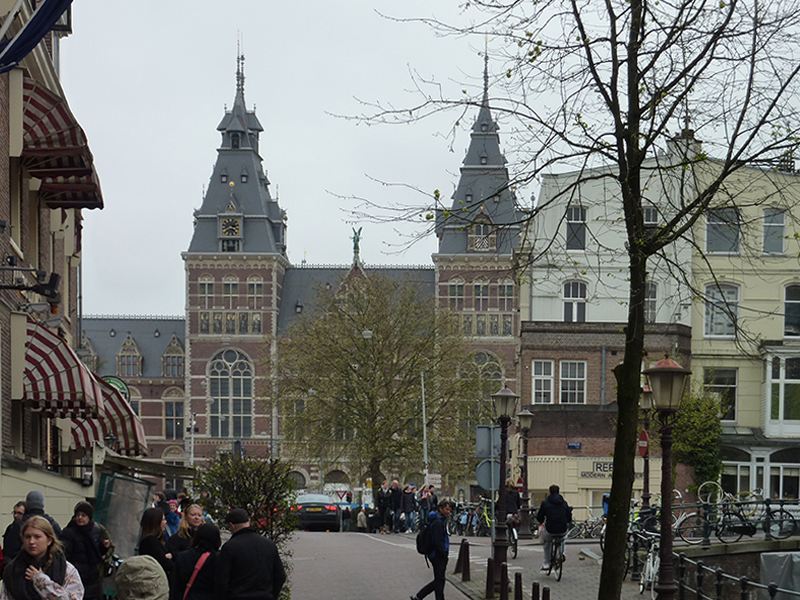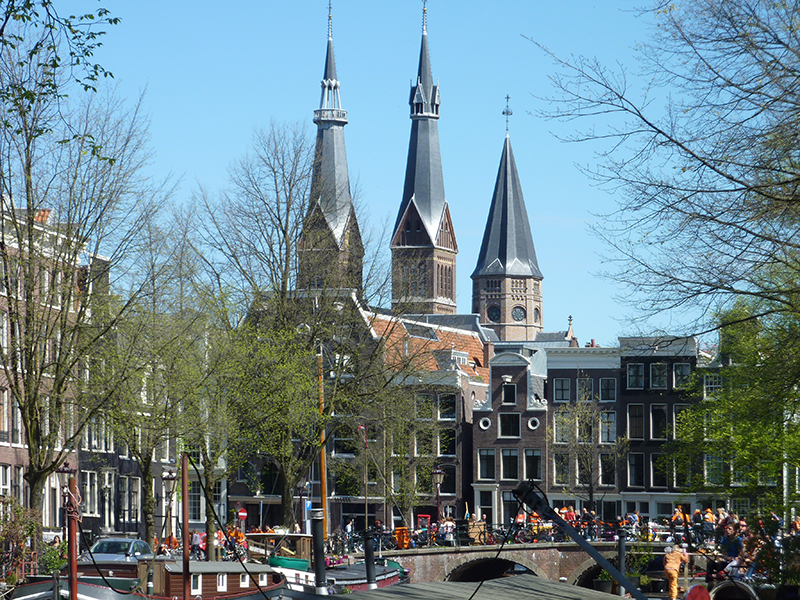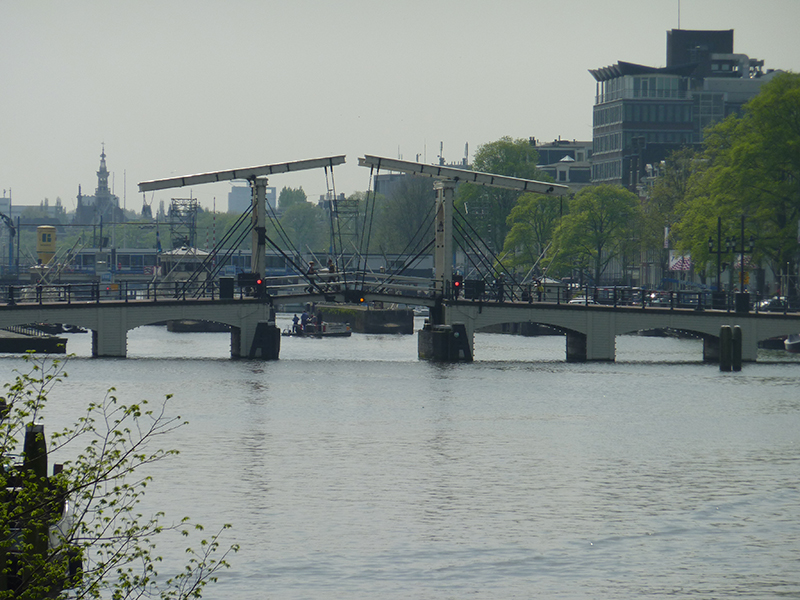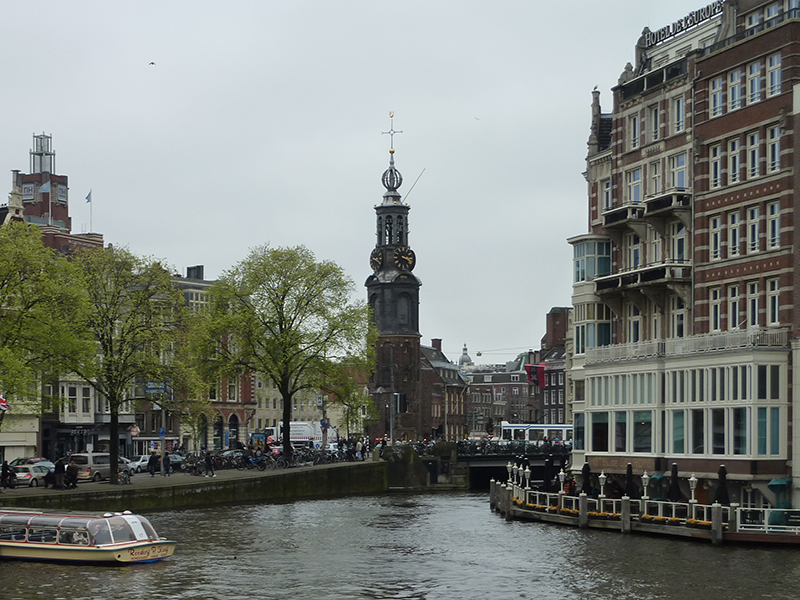
AMSTERDAM
Amstel river, in the background the Munttoren tower, viewed from the Halvemaansbrug bridgephoto: JD
Amsterdam is situated on an archipelago of almost 100 islands, where the Amstel River
 once flowed directly into the IJ Bay
once flowed directly into the IJ Bay  . Today Amstel ends in the city center at Muntplein
. Today Amstel ends in the city center at Muntplein , from where Rokin channel
, from where Rokin channel  (which until 1936 reached the main square of Amsterdam, known as Dam
(which until 1936 reached the main square of Amsterdam, known as Dam  but today Spui and Dam are connected by Rokin Street
but today Spui and Dam are connected by Rokin Street  ) continues northwest to the eastern end of Spui Square
) continues northwest to the eastern end of Spui Square  . The last section of the river is buried (water flows to IJ through underground channels, and Damrak Street
. The last section of the river is buried (water flows to IJ through underground channels, and Damrak Street  runs along the original river course), while the IJ looks more like the river (and it is most often called the river), the western section of which connects through the Noordzeekanaal with the North Sea, and the eastern section, called Biten-IJ, with Lake IJmeer.
runs along the original river course), while the IJ looks more like the river (and it is most often called the river), the western section of which connects through the Noordzeekanaal with the North Sea, and the eastern section, called Biten-IJ, with Lake IJmeer. stands for the Singel canal, once serving as a moat surrounding the city, today connecting the IJ (flowing into the IJ near the main railway station, Amsterdam Centraal
stands for the Singel canal, once serving as a moat surrounding the city, today connecting the IJ (flowing into the IJ near the main railway station, Amsterdam Centraal  ) with the Amstel River (in the Muntplein area). Further outwards, roughly parallel to the curve formed by the Singel canal, run Amsterdam's three largest canals: Herengracht
) with the Amstel River (in the Muntplein area). Further outwards, roughly parallel to the curve formed by the Singel canal, run Amsterdam's three largest canals: Herengracht  , Keizersgracht
, Keizersgracht  i Prinsengracht
i Prinsengracht  .
. 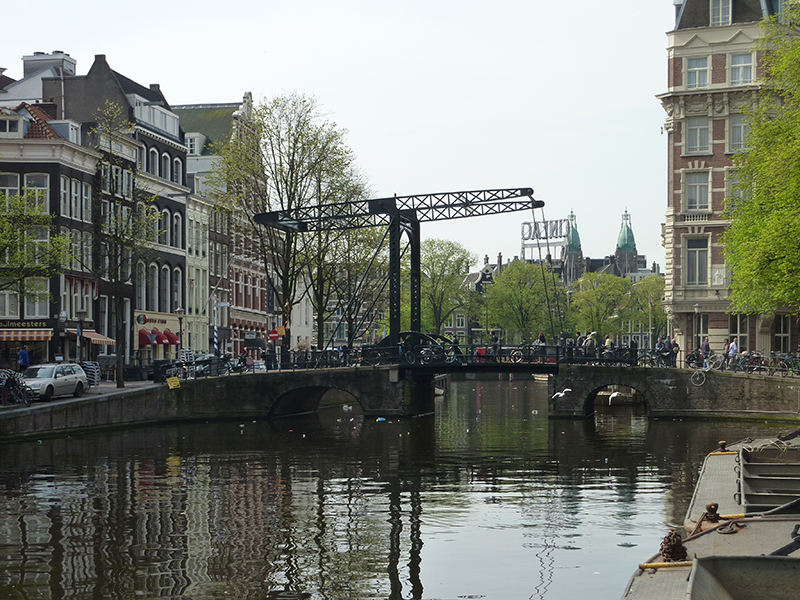
AMSTERDAM
Kloveniersburgwal, view to the south, in the foreground the Brug Aluminum Bridge, in the background the towers of the famous cinema building - Koninklijk Theater Tuschinskiphoto: JD
Grimburgwal canal
 , east of the Rokin canal north end, is the southern border of Amsterdam's "red light district" de Wallen; at its eastern end the Oudezijds Voorburgwal
, east of the Rokin canal north end, is the southern border of Amsterdam's "red light district" de Wallen; at its eastern end the Oudezijds Voorburgwal  and Oudezijds Achterburgwal
and Oudezijds Achterburgwal  channels begin, running roughly parallel to each other from southwest to northeast through the center of this district. Kloveniersburgwal channel
channels begin, running roughly parallel to each other from southwest to northeast through the center of this district. Kloveniersburgwal channel  , Nieuwmarkt
, Nieuwmarkt  and Geldersekade channel
and Geldersekade channel  , represent the eastern border of the historic city center.
, represent the eastern border of the historic city center.Amsterdam was founded as a small fishing village at the end of the 12th century, later than some other Dutch cities. At the beginning of the fourteenth century, it obtained city rights and in the following centuries it developed rapidly, mainly thanks to trade with the Hanseatic League, although an important factor was also the alleged miracle that happened in the city in 1345, already in 1346 recognized as a real miracle by the bishop Utrecht, which made Amsterdam for some time an important European pilgrimage destination. A particularly good period of development took place in the 16th century, after the creation of the Republic of the United Provinces, independent of the previously ruling Habsburgs, and the 17th century became the golden age of the city, when the Netherlands became a maritime and colonial power, and Amsterdam - one of the richest cities in Europe. In the 18th and early 19th centuries, the city's development slowed, but at the end of the 19th century, Amsterdam once again became one of the fastest-growing cities in the Western world. Today Amsterdam is the largest city of the Netherlands and the constitutional capital of the Kingdom of the Netherlands (although it is not the seat of government), an industrial, commercial, financial, scientific and cultural center, and also an important transport hub, with Schiphol international airport serving over 50 million passengers per year, the second largest in the Netherlands (after Rotterdam) and one of the largest seaports in Europe, a large (second largest in the Netherlands, after the station in Utrecht) railway station, and excellent road connections (thanks to the A10 bypass, to which the A1, A2, A4, A5 motorways lead and A8.)
Most of Amsterdam's main tourist attractions are in the historic city center, generally less than 1.5 km from the central square - Dam
 . The entire city center is well worth exploring, but there are two areas that are particularly noteworthy.
. The entire city center is well worth exploring, but there are two areas that are particularly noteworthy.One of them is the Binnenstad, the inner part of the historic center, occupying an area southwest of Amsterdam Central Station, Amsterdam Centraal
 , bounded to the west and south Singel channel
, bounded to the west and south Singel channel  and from the east through Kloveniersburgwal
and from the east through Kloveniersburgwal  , Geldersekade
, Geldersekade  and the Nieuwmarkt square
and the Nieuwmarkt square  between them. It consists of two main parts - Burgwallen Nieuwe Zijde, west of the original Amstel river on its last stretch (i.e. today west of the canal and Rokin
between them. It consists of two main parts - Burgwallen Nieuwe Zijde, west of the original Amstel river on its last stretch (i.e. today west of the canal and Rokin  and Damrak
and Damrak  streets) and Burgwallen Oude Zijde, east of this line.
streets) and Burgwallen Oude Zijde, east of this line. (with the Royal Palace
(with the Royal Palace  , the Nieuwe Kerk church
, the Nieuwe Kerk church  and the monumental neo-gothic and neo-renaissance building Magna Plaza
and the monumental neo-gothic and neo-renaissance building Magna Plaza  (formerly Amsterdam Post Office, today a shopping mall), (2) Nieuwendijk streets
(formerly Amsterdam Post Office, today a shopping mall), (2) Nieuwendijk streets  and Kalverstraat
and Kalverstraat  , one of the oldest in Amsterdam, today the main shopping streets of the city, (3) designed by Dutch architect Pierre Cuypers, opened in 1889, neo-gothic and neo-renaissance main railway station, Amsterdam Centraal
, one of the oldest in Amsterdam, today the main shopping streets of the city, (3) designed by Dutch architect Pierre Cuypers, opened in 1889, neo-gothic and neo-renaissance main railway station, Amsterdam Centraal  , (4) mentioned already above place Spui
, (4) mentioned already above place Spui  i Muntplein
i Muntplein  , and (5) the courtyard of Begijnhof
, and (5) the courtyard of Begijnhof  , surrounded by historic houses, one of which is one of the oldest in Amsterdam.
, surrounded by historic houses, one of which is one of the oldest in Amsterdam. In the Oude Zijde district, the main monuments are (1) the Oude Kerk church
 and Basiliek van de H. Nicolaas
and Basiliek van de H. Nicolaas  ), (2) the 17th century house with a secret Catholic church Ons' Lieve Heer op Solder
), (2) the 17th century house with a secret Catholic church Ons' Lieve Heer op Solder  in the attic (secret when Catholicism was forbidden in Amsterdam), (3) former stock exchange, Beurs van Berlage
in the attic (secret when Catholicism was forbidden in Amsterdam), (3) former stock exchange, Beurs van Berlage  , and (4) historic streets Warmoesstraat
, and (4) historic streets Warmoesstraat  and Zeedijk
and Zeedijk  with some of Amsterdam's oldest houses. A special attraction - drawing more tourists to the Oude Zijde than anything else - is de Wallen, the "red light district", on both sides of the Oudezijds Voorburgwal canals
with some of Amsterdam's oldest houses. A special attraction - drawing more tourists to the Oude Zijde than anything else - is de Wallen, the "red light district", on both sides of the Oudezijds Voorburgwal canals  and Oudezijds Achterburgwal
and Oudezijds Achterburgwal  running from the eastern end of the Grimburgwal Channel
running from the eastern end of the Grimburgwal Channel  to the northeast.
to the northeast. The second most popular tourist area of Amsterdam is the area of Museumplein
 , located southwest of the center of Binnenstad square, surrounded by Amsterdam's most important cultural institutions, including the Rijksmuseum
, located southwest of the center of Binnenstad square, surrounded by Amsterdam's most important cultural institutions, including the Rijksmuseum  , Van Gogh Museum
, Van Gogh Museum  , Stedelijk Museum
, Stedelijk Museum  , and the famous Concertgebouw
, and the famous Concertgebouw  .
.Nieuwe Zijde
The center of Nieuwe Zijde and the main square of Amsterdam is Dam  - an approximately rectangular, latitudinal square, approx. 200 m long and approx. 100 m wide, located approximately 750 meters south-west of Central Railway Station
- an approximately rectangular, latitudinal square, approx. 200 m long and approx. 100 m wide, located approximately 750 meters south-west of Central Railway Station  , where the Amstel dam once stood. From the north-east, from the side of the station, a wide street Damrak
, where the Amstel dam once stood. From the north-east, from the side of the station, a wide street Damrak  (often called the avenue) leads to the square. Before the exit to IJ, Rokin Street (avenue) comes south, leading to Muntplein Square
(often called the avenue) leads to the square. Before the exit to IJ, Rokin Street (avenue) comes south, leading to Muntplein Square  . The two main shopping streets of Amsterdam, mentioned above Nieuwendijk
. The two main shopping streets of Amsterdam, mentioned above Nieuwendijk  (north-east) and Kalverstraat
(north-east) and Kalverstraat  (south), also run from Dam.
(south), also run from Dam.On the west side of the square is the Royal Palace
 , and to the north there is a 15th-century Gothic church known as Nieuwe Kerk
, and to the north there is a 15th-century Gothic church known as Nieuwe Kerk  , one of the two oldest in Amsterdam. In the eastern part of Dam, formally beyond the border between Nieuwe Zijde and Oude Zijde, stands a stone column
, one of the two oldest in Amsterdam. In the eastern part of Dam, formally beyond the border between Nieuwe Zijde and Oude Zijde, stands a stone column  erected in 1956 as a national monument (Nationaal Monument ) commemorating the victims of the Second World War. Dam Square, in particular the area around the column, is often a venue for gatherings, demonstrations and events of all kinds.
erected in 1956 as a national monument (Nationaal Monument ) commemorating the victims of the Second World War. Dam Square, in particular the area around the column, is often a venue for gatherings, demonstrations and events of all kinds. (Koninklijk Paleis van Amsterdam) is one of the three palaces at the disposal of the Dutch royal family (although not residence or seat of state authorities). It was built in the 17th century (opened in 1655) as a town hall. It became a royal palace for the first time at the beginning of the 19th century, when Napoleon Bonaparte, already ruling over the Netherlands, dissolved the so-called Republic of Batavia and established the Kingdom of the Netherlands by enthroning his younger brother, Louis Napoleon. The palace in Amsterdam has been owned by the Kingdom of the Netherlands since 1936. It is used, among others during state visits, official receptions, award ceremonies, etc. The palace is partially open to the public.
(Koninklijk Paleis van Amsterdam) is one of the three palaces at the disposal of the Dutch royal family (although not residence or seat of state authorities). It was built in the 17th century (opened in 1655) as a town hall. It became a royal palace for the first time at the beginning of the 19th century, when Napoleon Bonaparte, already ruling over the Netherlands, dissolved the so-called Republic of Batavia and established the Kingdom of the Netherlands by enthroning his younger brother, Louis Napoleon. The palace in Amsterdam has been owned by the Kingdom of the Netherlands since 1936. It is used, among others during state visits, official receptions, award ceremonies, etc. The palace is partially open to the public.Nieuwe Kerk
 ("New Church") is the second oldest church in Amsterdam (after Oude Kerk, "Old Church"), with a history dating back to the early 15th century century. It was originally dedicated to the Mother of God and St. Catherine. During its history, it was destroyed by fires and rebuilt several times. After reconstruction in 1578, it was taken over by Protestants. The last major renovations took place in 1892-1914 and in 1959-1980. Today, Nieuwe Kerk no longer performs religious functions, but functions as a cultural center (exhibitions, organ concerts, etc.); since 1814, the inaugural ceremonies of successive rulers of the Kingdom of the Netherlands have been held here.
("New Church") is the second oldest church in Amsterdam (after Oude Kerk, "Old Church"), with a history dating back to the early 15th century century. It was originally dedicated to the Mother of God and St. Catherine. During its history, it was destroyed by fires and rebuilt several times. After reconstruction in 1578, it was taken over by Protestants. The last major renovations took place in 1892-1914 and in 1959-1980. Today, Nieuwe Kerk no longer performs religious functions, but functions as a cultural center (exhibitions, organ concerts, etc.); since 1814, the inaugural ceremonies of successive rulers of the Kingdom of the Netherlands have been held here.A special attraction of Nieuwe Zijde is the Begijnhof
 - a courtyard surrounded by houses probably dating back to the mid-fourteenth century (although the first mentions come from 1389). One of these houses, number 34, is considered to be one of the two oldest wooden houses preserved in Amsterdam to our times (the other is at number 1 on Zeedijk Street). You can enter the courtyard from the east (intersection of Gedempte Begijnensloot and Begijnensteeg streets) or from the south, from Spui Square
- a courtyard surrounded by houses probably dating back to the mid-fourteenth century (although the first mentions come from 1389). One of these houses, number 34, is considered to be one of the two oldest wooden houses preserved in Amsterdam to our times (the other is at number 1 on Zeedijk Street). You can enter the courtyard from the east (intersection of Gedempte Begijnensloot and Begijnensteeg streets) or from the south, from Spui Square  , a fairly large, long square stretching from the southwest to the northeast between the Singel channel
, a fairly large, long square stretching from the southwest to the northeast between the Singel channel  and the northern end of the Rokin channel
and the northern end of the Rokin channel  . Originally it was a water reservoir that formed the southern border of the city. In 1882, the reservoir was backfilled. Today, Spui Square is known as the area of bookstores and antiquities, and the site of the weekly art fairs.
. Originally it was a water reservoir that formed the southern border of the city. In 1882, the reservoir was backfilled. Today, Spui Square is known as the area of bookstores and antiquities, and the site of the weekly art fairs.Muntplein Square
 lies at the southern end of Nieuwe Zijde and is actually a bridge over the Singel canal where it joins the Amstel River. The name of the square comes from the Munttoren tower
lies at the southern end of Nieuwe Zijde and is actually a bridge over the Singel canal where it joins the Amstel River. The name of the square comes from the Munttoren tower  which used to be part of one of the three main city gates in the Middle Ages, and in the 17th century it served as the mint (the tower itself is a monument - the adjoining building is from the end of the 19th century). Muntplein forms the southern end of both Rokin Avenue and Kalverstraat. In the immediate vicinity of Muntplein is the eastern end of Amsterdam's famous flower market (Bloemenmarkt
which used to be part of one of the three main city gates in the Middle Ages, and in the 17th century it served as the mint (the tower itself is a monument - the adjoining building is from the end of the 19th century). Muntplein forms the southern end of both Rokin Avenue and Kalverstraat. In the immediate vicinity of Muntplein is the eastern end of Amsterdam's famous flower market (Bloemenmarkt  ), floating on the southern shore of the Singel Channel.
), floating on the southern shore of the Singel Channel. Oude Zijde
The western borders of Oude Zijde form, from the north, Damrak avenue  , and behind the Dam Square, Rokin avenu
, and behind the Dam Square, Rokin avenu  and Rokin channel
and Rokin channel  , and eastern borders - Kloveniersburgwal channel
, and eastern borders - Kloveniersburgwal channel  (from the Amstel river to Nieuwmarkt square
(from the Amstel river to Nieuwmarkt square  ) and Geldersekade
) and Geldersekade  (from Nieuwmarkt square to Prins Hendrikkade). As already mentioned, the main monuments of Oude Zijde are two churches: Oude Kerk
(from Nieuwmarkt square to Prins Hendrikkade). As already mentioned, the main monuments of Oude Zijde are two churches: Oude Kerk  and Basiliek van de H. Nicolaas
and Basiliek van de H. Nicolaas  , and former headquarters of the commodity exchange (Beurs van Berlage
, and former headquarters of the commodity exchange (Beurs van Berlage  ), designed by architect Hendrik Petrus Berlage and built between 1896-1903, today functioning as a venue for concerts, exhibitions and conferences. Two oldest streets in Amsterdam also run through Oude Zijde: Warmoesstraat
), designed by architect Hendrik Petrus Berlage and built between 1896-1903, today functioning as a venue for concerts, exhibitions and conferences. Two oldest streets in Amsterdam also run through Oude Zijde: Warmoesstraat  and Zeedijk
and Zeedijk  , and Oudezijds Voorburgwal
, and Oudezijds Voorburgwal  i Oudezijds Achterburgwal
i Oudezijds Achterburgwal  , around which is Amsterdam's "red light district".
, around which is Amsterdam's "red light district". , with a history dating back to the early 13th century, consecrated in 1306 by the bishop of Utrecht, originally dedicated to St. Nicholas, is the oldest church in Amsterdam. In 1578 it was taken over by Protestants. Over the centuries of its history, it was destroyed and rebuilt many times. It is famous for the largest preserved wooden vault in Europe from the Middle Ages, as well as the organ (known as the Vater-Müller organ), built by Christian Vater in 1724-1726, later rebuilt by Casper Müller, today considered one of the best Baroque organs in Europe. In the Oude Kerk, there are the graves of thousands of Amsterdam residents (burials in the church were stopped only in 1865) - among others, Rembrandt's wife, Saskia van Uylenburgh, as well as composer and organist Jan Pieterszoon Sweelinck, and Frans Banning Cocq, Mayor of Amsterdam immortalized as the main character of Rembrandt's famous work, The Night Watch. The church still performs religious functions, but also functions as a museum of contemporary art. It is worth knowing that a few dozen meters north-east of the Oude Kerk, at Oudezijds Voorburgwal, there is the above-mentioned 17th-century tenement house
, with a history dating back to the early 13th century, consecrated in 1306 by the bishop of Utrecht, originally dedicated to St. Nicholas, is the oldest church in Amsterdam. In 1578 it was taken over by Protestants. Over the centuries of its history, it was destroyed and rebuilt many times. It is famous for the largest preserved wooden vault in Europe from the Middle Ages, as well as the organ (known as the Vater-Müller organ), built by Christian Vater in 1724-1726, later rebuilt by Casper Müller, today considered one of the best Baroque organs in Europe. In the Oude Kerk, there are the graves of thousands of Amsterdam residents (burials in the church were stopped only in 1865) - among others, Rembrandt's wife, Saskia van Uylenburgh, as well as composer and organist Jan Pieterszoon Sweelinck, and Frans Banning Cocq, Mayor of Amsterdam immortalized as the main character of Rembrandt's famous work, The Night Watch. The church still performs religious functions, but also functions as a museum of contemporary art. It is worth knowing that a few dozen meters north-east of the Oude Kerk, at Oudezijds Voorburgwal, there is the above-mentioned 17th-century tenement house  , on the top floors of which there was for a time a secret Catholic church. It ceased to perform religious functions after the opening of the church of St. Nicholas and has been transformed into a museum, visited by tens of thousands of people a year (originally the museum was called "Museum Amstelkring", now - "Museum Ons' Lieve Heer op Solder").
, on the top floors of which there was for a time a secret Catholic church. It ceased to perform religious functions after the opening of the church of St. Nicholas and has been transformed into a museum, visited by tens of thousands of people a year (originally the museum was called "Museum Amstelkring", now - "Museum Ons' Lieve Heer op Solder").The aforementioned St. Nicholas church
 (Basiliek van de H. Nicolaas) - is a Roman Catholic church built in 1884-1887 at Prins Hendrikkade at number 76, opposite Amsterdam Central Station. The church is a three-nave basilica designed by the architect Adrianus Bleijs in the neo-Renaissance and neo-baroque styles, with a richly decorated interior. The church has a religious function (Catholic and Anglican), but organ concerts are also held regularly.
(Basiliek van de H. Nicolaas) - is a Roman Catholic church built in 1884-1887 at Prins Hendrikkade at number 76, opposite Amsterdam Central Station. The church is a three-nave basilica designed by the architect Adrianus Bleijs in the neo-Renaissance and neo-baroque styles, with a richly decorated interior. The church has a religious function (Catholic and Anglican), but organ concerts are also held regularly.Nieuwmarkt
 , located on the eastern border of the Oude Zijde, between the Kloveniersburgwal
, located on the eastern border of the Oude Zijde, between the Kloveniersburgwal  and Geldersekade
and Geldersekade  channels, was created in the first half of the 16th century and served as a market. While being here, it is worth paying attention to the building known as Waag
channels, was created in the first half of the 16th century and served as a market. While being here, it is worth paying attention to the building known as Waag  , originally a gate in the medieval city walls, later serving as an urban weight hall.
, originally a gate in the medieval city walls, later serving as an urban weight hall. Museumkwartier - the museum district
Museumplein  - is a large public space located in a neighborhood known as Museumkwartier, about 1.5 km southwest of the city center, created in the 1980s, reconstructed at the end of the twentieth century, used to organize large exhibitions, festivals, demonstrations, various types of celebrations, mass concerts, sports competitions, etc. In the area of the square there are probably four most important cultural institutions of Amsterdam: Rijksmuseum
- is a large public space located in a neighborhood known as Museumkwartier, about 1.5 km southwest of the city center, created in the 1980s, reconstructed at the end of the twentieth century, used to organize large exhibitions, festivals, demonstrations, various types of celebrations, mass concerts, sports competitions, etc. In the area of the square there are probably four most important cultural institutions of Amsterdam: Rijksmuseum  , Van Gogh Museum
, Van Gogh Museum  Stedelijk Museum
Stedelijk Museum  , and Concertgebouw
, and Concertgebouw  .
. is one of Amsterdam's top tourist attractions. The museum was founded in The Hague in 1798, but 10 years later it was moved to Amsterdam, where it was originally located in today's Royal Palace at the Dam. The present building of the museum, designed by Pierre Cuypers, was opened in 1885 and reopened in 2013 by Queen Beatrice after the reconstruction. The museum exhibits paintings, prints, sculpture, applied arts and handicrafts. The exhibited collection of paintings includes several thousand works, including Rembrandt, students of Rembrandt, Johannes Vermeer, Frans Hals, Jacob van Ruisdael, et al. The Rijksmuseum is the most visited museum in the Netherlands (over 2 million visitors per year).
is one of Amsterdam's top tourist attractions. The museum was founded in The Hague in 1798, but 10 years later it was moved to Amsterdam, where it was originally located in today's Royal Palace at the Dam. The present building of the museum, designed by Pierre Cuypers, was opened in 1885 and reopened in 2013 by Queen Beatrice after the reconstruction. The museum exhibits paintings, prints, sculpture, applied arts and handicrafts. The exhibited collection of paintings includes several thousand works, including Rembrandt, students of Rembrandt, Johannes Vermeer, Frans Hals, Jacob van Ruisdael, et al. The Rijksmuseum is the most visited museum in the Netherlands (over 2 million visitors per year).Van Gogh Museum
 , devoted to the life and work of Vincent Van Gogh, has the world's largest collection of over 200 paintings, 500 drawings and 700 artist letters, as well as a collection of various related mementos; the museum's library also houses a rich collection of books and other publications related to the work of Van Gogh. The core of the collection are works originally owned by the artist's younger brother, Theo van Gogh, inherited by his widow and then by his son, Vincent Willem van Gogh (1890-1978). In 1962, the collection was given as a permanent deposit to the emerging museum, opened in 1973. In addition to the works of Vincent van Gogh, the museum also exhibits works by, among others, Gauguin, Toulouse-Lautrec, and other Impressionists.
, devoted to the life and work of Vincent Van Gogh, has the world's largest collection of over 200 paintings, 500 drawings and 700 artist letters, as well as a collection of various related mementos; the museum's library also houses a rich collection of books and other publications related to the work of Van Gogh. The core of the collection are works originally owned by the artist's younger brother, Theo van Gogh, inherited by his widow and then by his son, Vincent Willem van Gogh (1890-1978). In 1962, the collection was given as a permanent deposit to the emerging museum, opened in 1973. In addition to the works of Vincent van Gogh, the museum also exhibits works by, among others, Gauguin, Toulouse-Lautrec, and other Impressionists.The Stedelijk Museum
 is considered to be one of the most important European collections of contemporary art.
The museum building, architecturally referring to the 16th-century Dutch Renaissance, was completed in 1895; in 1954 it was enlarged. The display of own collections is changed from time to time; temporary exhibitions are also organized.
is considered to be one of the most important European collections of contemporary art.
The museum building, architecturally referring to the 16th-century Dutch Renaissance, was completed in 1895; in 1954 it was enlarged. The display of own collections is changed from time to time; temporary exhibitions are also organized.The marker
 stands for the famous Concertgebouw concert hall, considered - in terms of acoustics - one of the best in the world. The building is the seat of the Royal Concertgebouw Orchestra (Koninklijk Concertgebouworkest), also one of the best in the world, which has been giving concerts here since 1888 (the title of the "royal" orchestra was given to the ensemble in 1988 by Queen Beatrice).
stands for the famous Concertgebouw concert hall, considered - in terms of acoustics - one of the best in the world. The building is the seat of the Royal Concertgebouw Orchestra (Koninklijk Concertgebouworkest), also one of the best in the world, which has been giving concerts here since 1888 (the title of the "royal" orchestra was given to the ensemble in 1988 by Queen Beatrice).The marker
 marks the large (47 hectares) Vondelpark - a city park opened in 1865, one of the most beautiful and popular in Amsterdam, visited annually by approx. 10 million people. The park was originally called "Nieuwe Park", but was later renamed, and its current name is to commemorate the 17th-century Dutch playwright and poet Joost van den Vondel.
marks the large (47 hectares) Vondelpark - a city park opened in 1865, one of the most beautiful and popular in Amsterdam, visited annually by approx. 10 million people. The park was originally called "Nieuwe Park", but was later renamed, and its current name is to commemorate the 17th-century Dutch playwright and poet Joost van den Vondel.Amsterdam's other tourist attractions
As mentioned above, most of Amsterdam's attractions are in the city center. However, there are a few places outside of the city that are worth visiting. They include, among others (1) Maritime Museum  (Scheepvaartmuseum), (2) two biographical museums, one located in Rembrandt's former home
(Scheepvaartmuseum), (2) two biographical museums, one located in Rembrandt's former home  (Rembrandthuis), the second - dedicated to Anne Frank
(Rembrandthuis), the second - dedicated to Anne Frank  (Anne Frank Huis), the author of the famous Diary of Anne Frank , and (3) two of the first three churches in Amsterdam not taken over from Catholics but built as Protestant, Zuiderker
(Anne Frank Huis), the author of the famous Diary of Anne Frank , and (3) two of the first three churches in Amsterdam not taken over from Catholics but built as Protestant, Zuiderker  i Westerkerk
i Westerkerk  .
.  - is a museum dedicated to the maritime history of the Netherlands. Since 1973, it has been housed in the former naval warehouse (Lands Zeemagazijn or Admiraliteits Magazijn), built in 1656 according to the design of the Dutch architect Daniël Stalpaert. In 2007-2011 it underwent a major renovation. In the museum you can see models of sailing ships and warships, navigational instruments, weapons, maps, paintings depicting eminent representatives of the Dutch navy, paintings depicting sea battles, etc. The museum is one of the most popular in the Netherlands, visited by several hundred thousand people annually.
- is a museum dedicated to the maritime history of the Netherlands. Since 1973, it has been housed in the former naval warehouse (Lands Zeemagazijn or Admiraliteits Magazijn), built in 1656 according to the design of the Dutch architect Daniël Stalpaert. In 2007-2011 it underwent a major renovation. In the museum you can see models of sailing ships and warships, navigational instruments, weapons, maps, paintings depicting eminent representatives of the Dutch navy, paintings depicting sea battles, etc. The museum is one of the most popular in the Netherlands, visited by several hundred thousand people annually.Rembrandthuis
 is the dating back to the first half of the 16th century house where Rembrandt lived and worked for almost 20 years, restored in 1907-1911 and transformed into the artist's biographical museum (Museum het Rembrandthuis), located at number 4 Jodenbreesraat. Reconstructed interiors allow visitors to imagine what the artist's apartment and studio looked like; in the building added in 1990 adjacent to the Rembrandt house and connected to it, you can see, among others, a rich collection of the artist's drawings and etchings. About 500 m south-west of the Rembrandt house, on the left bank of the Amstel River, it lies
Rembrandtplein
is the dating back to the first half of the 16th century house where Rembrandt lived and worked for almost 20 years, restored in 1907-1911 and transformed into the artist's biographical museum (Museum het Rembrandthuis), located at number 4 Jodenbreesraat. Reconstructed interiors allow visitors to imagine what the artist's apartment and studio looked like; in the building added in 1990 adjacent to the Rembrandt house and connected to it, you can see, among others, a rich collection of the artist's drawings and etchings. About 500 m south-west of the Rembrandt house, on the left bank of the Amstel River, it lies
Rembrandtplein  , a popular square, recently restored (in the first decade of the 21st century), on which stands a cast-iron statue of Rembrandt by Louis Royer, made in 1852. Even closer, just 120 meters northwest of Rembrandt's house, stands the Zeuiderkerk
, a popular square, recently restored (in the first decade of the 21st century), on which stands a cast-iron statue of Rembrandt by Louis Royer, made in 1852. Even closer, just 120 meters northwest of Rembrandt's house, stands the Zeuiderkerk  , the first church in Amsterdam not taken over from Catholics, but built for Protestants. The church played an important role in Rembrandt's life: here are the graves of three of his children who died in early childhood, here in 1641 his fourth child, Titus van Rijn (the only child of Rembrandt and Saskia van Uylenburgh who lived to adulthood) was baptized. The church was built at the beginning of the 17th century in the Renaissance style, according to the design of the then city architect Hendrick de Keyser. The church performed religious functions until 1929; now it hosts gatherings and cultural events (as well as private events such as weddings, etc.). The tower is open to the public and offers a great view.
, the first church in Amsterdam not taken over from Catholics, but built for Protestants. The church played an important role in Rembrandt's life: here are the graves of three of his children who died in early childhood, here in 1641 his fourth child, Titus van Rijn (the only child of Rembrandt and Saskia van Uylenburgh who lived to adulthood) was baptized. The church was built at the beginning of the 17th century in the Renaissance style, according to the design of the then city architect Hendrick de Keyser. The church performed religious functions until 1929; now it hosts gatherings and cultural events (as well as private events such as weddings, etc.). The tower is open to the public and offers a great view.The church known as Westerkerk
 is also one of the first churches built in Amsterdam by Protestants. Designed by Hendrick de Keyser, it was built between 1620 and 1631 in the Jordaan district, west of the city center (Hendrick de Keyser died in 1621 and was buried in Zuiderkerk, but the construction of the Westerkerk church was continued by his son, Pieter de Keyser). The church is one of the largest Protestant churches in the world and has the tallest tower in Amsterdam, rising to a height of 85 meters. Rembrandt was buried in Westerkerk, but since he died a poor man, the place where the artist's remains were eventually found is unknown. In 1996, at the Westerkerk, Queen Beatrice (then a princess) married Prince Claus von Amsberg. The Westerkerk stands near the house marked with a marker
is also one of the first churches built in Amsterdam by Protestants. Designed by Hendrick de Keyser, it was built between 1620 and 1631 in the Jordaan district, west of the city center (Hendrick de Keyser died in 1621 and was buried in Zuiderkerk, but the construction of the Westerkerk church was continued by his son, Pieter de Keyser). The church is one of the largest Protestant churches in the world and has the tallest tower in Amsterdam, rising to a height of 85 meters. Rembrandt was buried in Westerkerk, but since he died a poor man, the place where the artist's remains were eventually found is unknown. In 1996, at the Westerkerk, Queen Beatrice (then a princess) married Prince Claus von Amsberg. The Westerkerk stands near the house marked with a marker  , where Anne Frank was hiding during the German occupation of the Netherlands (there is a statue of hers near the church).
, where Anne Frank was hiding during the German occupation of the Netherlands (there is a statue of hers near the church).Photo gallery
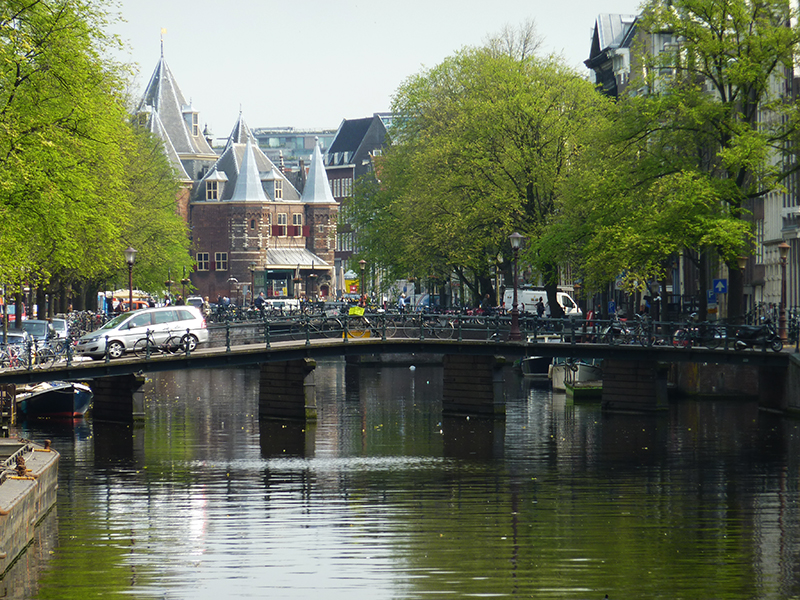
AMSTERDAM
Kloveniersburgwal canal, view to the north east, in the hinterland of the Waag at the Nieuwmarktphoto: JD

AMSTERDAM
view from the Lekkeresluis bridge to the southwest, on the far left the tower of the Westerkerk churchphoto: JD

AMSTERDAM
Amstel river, in the middle the Staalmeestersbrug drawbridge on the Groenburgwal canal, the tower of the Zuiderkerk church in the backgroundphoto: JD
